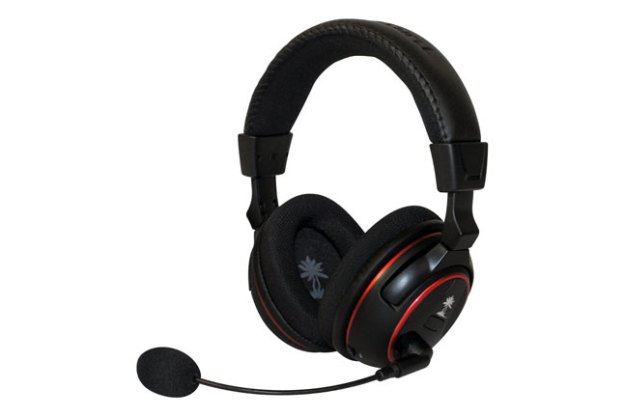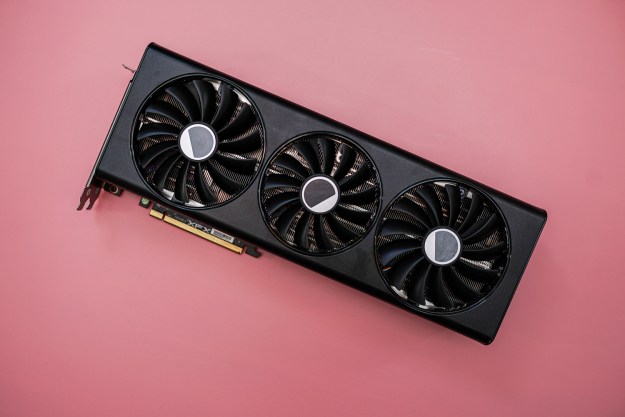
“Turtle Beach’s Ear Force PX5 wireless headset is not for everyone, but those who want the best gaming headset on the market need look no further.”
- Over a dozen presets, great sound isolation
- Durable
- Can also operate as a Bluetooth headset for a phone or other Bluetooth design
- Amazing surround sound for gaming
- High price tag
- Occasional interference from other wireless signals
When it comes to the Xbox 360 and PS3, the headset selection has been fairly basic. There are some good units out there to be sure, but there hasn’t been that one headset that is the choice for the hardcore and professional gamers, that one headset to rule them all. Until now. It also works on the PC, which is almost unfair to other headsets.
The Turtle Beach PX5 headset is not for the faint of heart. It is expensive, its options can be overwhelming, and to fully utilize the thing you need to be something of an audio engineer. If you are looking for something simple to avoid irritating the roommates or infuriating the spouse with sounds of online gunfire, then there are cheaper models that might be better suited for you. But for the sound connoisseurs, for the audiophiles that are looking for the most technologically advanced headset out there, for the people that take their gaming very, very seriously, the PX5 are the best gaming headphones money can buy.
 Out of the box
Out of the box
The PX5 box is no joke. A plastic cover protects the headset and transmitter, and as you dig further in, you’ll find the user’s guide, a quick set-up sheet, a presets reference card and a box filled with lots of cables. The PX5 is designed to work on either the Xbox 360 or the PS3, but the set up for each is different, and of the two, the PS3’s Bluetooth is much simpler, as the Xbox 360 requires wired connections to the console (via an included digital optical cable) and one to the controller for voice chat (if you don’t want to chat you can unplug this). You will also need to connect the transmitter to a USB port to power it. A second USB programming cable is included to connect the headset to a computer to download more preset options, or mix your own audio. A removable microphone that when connected can swivel either way is also included. The PX5 even includes the two AA batteries you need for the headset.
Features and design
The PX5 headset is an attractive black with red highlights and white lettering on the sides, giving it a simple and modern look. The unit is bigger than many other console headsets, but the weight isn’t an issue. The weight distribution, sturdy frame and the cushioning make the PX5 comfortable over the long haul except for one minor issue. The ear cushions fit firmly over the ears, which provides some sound cancellation, but can also lead to warm and sweaty ears that will need to breathe now and then. Still, it’s something of a necessary evil to get the performance that the enclosed ear cushions offer.
The wireless transmitter is unobtrusive enough, and while the USB power connection is nice, an AC-to-USB power adapter — which can be purchased separately — may appeal to people that don’t have the console USB slots to spare. One unfortunate drawback shows up with the original-style Xbox models. If it is hooked up via an HDMI cable and not the component cable that has the digital optical connection, there is nowhere to plug the transmitter into. This is more of a flaw with the Xbox 360 design than the PX5, though.

The PX5 also allows other devices to connect via Bluetooth while connected. So if you are playing a game and someone calls on your Bluetooth enabled cell phone, you can answer and talk through that. You can also stream music to the headset via Bluetooth while still playing and hearing a game, which is an excellent touch, although the sound is not nearly as good as through the wireless transmitter’s signal.

Performance
The performance of the PX5 is going to be determined by what you want from it. There are two sets of nine presets (for 18 in total) loaded by default, and they can be switched out when connected to a computer. Each of the presets can be used for a different scenario and selected when needed before switching back to the primary preset you prefer. The choices are utterly staggering.
Say you are playing Call of Duty: Black Ops online, and you have just irritated a great number of people by massacring them. You know they are coming for you, so every advantage you can get will help. With the touch of a button, the next preset might offer an emphasis on the sound of footsteps so you can hear where they are and estimate when they will be there. Hit the button again and you can listen for the sound of a grenade landing. If there is a sniper owning you, you can switch to the preset that will amplify the sound of a sniper rifle and follow your ears until you find him.

The headset also has the option of using standard unfiltered stereo sound, Dolby 5.1 and Dolby 7.1 surround sound. The digital signal processing isolates game sound, mic sound and chat sound individually, which makes it easier to adjust whichever you would like. The PX5 always seems to give you the choices to do whatever you want, however you want, and it does them all very well.
Watching movies is also an experience, especially movies that utilize surround sound with complex audio — i.e. a gunfight or rain falling. They are as good as any headset on the market.

Conclusion
The PX5 will cost you, and for the average gamer, $250 is a price that may not be worth paying, especially if you already have a decent surround sound setup up, or simply aren’t that much of a sound purist. But purchasing the PX5 is akin to purchasing a Ferrari — sure they are expensive and there are far more reasonably priced ways to get around — but still, it’s a Ferrari.
The sound options are incredible, and there is literally nothing you can’t do in terms of sound engineering. In terms of technically sophisticated headsets, especially for the PS3 and Xbox 360, nothing even comes close to the PX5. Watching movies on them is impressive when the 7.1 kicks in, but gaming is where this headset really shines. The presets are unbelievable and anything you can think to do with sound can be done with the audio options.
Turtle Beach’s Ear Force PX5 wireless headset is not for everyone, but those that have — or just want — the best gaming headset on the market need look no further.
Highs:
- Over a dozen presets, great sound isolation
- Durable
- Can also operate as a Bluetooth headset for a phone or other Bluetooth design
- Amazing surround sound for gaming
Lows:
- High price tag
- Occasional interference from other wireless signals




